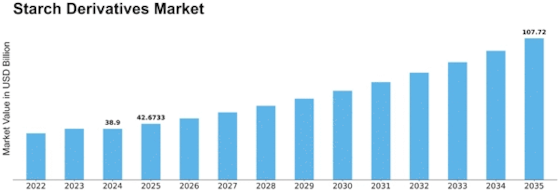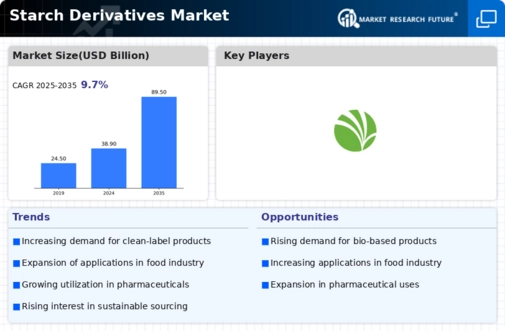Starch Derivatives Size
Starch Derivatives Market Growth Projections and Opportunities
The Starch Derivatives Market, a crucial segment of the global food and industrial ingredient industry, is subject to a multitude of market factors that significantly influence its dynamics. One of the key drivers shaping the market is the increasing demand for convenience foods. As consumer lifestyles continue to evolve, the preference for easily accessible and ready-to-eat products rises. Starch derivatives, with their versatile applications in enhancing texture, stability, and shelf life, become indispensable in the formulation of such convenience foods.
Moreover, the growing awareness of health and wellness is a pivotal factor impacting the Starch Derivatives Market. With consumers becoming more health-conscious, there is a shift towards natural and clean-label products. This shift is driving the demand for starch derivatives derived from natural sources, such as tapioca and corn. As a result, market players are focusing on developing and promoting starch derivatives with clean and simple ingredient profiles to meet the evolving preferences of health-conscious consumers.
The agricultural landscape and commodity prices also play a vital role in shaping the Starch Derivatives Market. The availability and pricing of raw materials, particularly starch sources like corn, wheat, and cassava, directly impact production costs and, subsequently, the pricing of starch derivatives. Fluctuations in crop yields, weather conditions, and global trade policies can contribute to volatility in raw material prices, affecting the profit margins of market players.
Furthermore, technological advancements and innovations in the starch processing industry significantly influence the market dynamics. Continuous efforts are being made to improve extraction and modification processes, resulting in enhanced product quality and functionality. The development of novel starch derivatives with improved characteristics, such as better stability, solubility, and thickening properties, creates new opportunities and keeps the market competitive.
Government regulations and policies also exert a significant influence on the Starch Derivatives Market. Regulatory standards related to food safety, labeling, and environmental sustainability impact the manufacturing, marketing, and distribution practices of starch derivatives. Compliance with these regulations is crucial for market players to ensure the quality and safety of their products, as well as to meet the expectations of increasingly informed and discerning consumers.
Global economic conditions and geopolitical factors contribute to the overall market stability and growth. Economic downturns can affect consumer spending patterns, influencing the demand for starch derivatives in various applications, including food, pharmaceuticals, and textiles. Additionally, trade tensions and geopolitical uncertainties may impact the supply chain, affecting the availability and pricing of starch derivatives in the global market.


















Leave a Comment